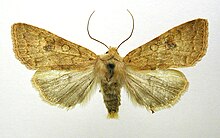Agrochola circellaris, or The Brick, is a species of moth of the family Noctuidae. The species was first described by Johann Siegfried Hufnagel in 1766. It is distributed throughout most of Europe, Asia Minor and Armenia.
| The Brick | |
|---|---|

| |

| |
| Scientific classification | |
| Domain: | Eukaryota |
| Kingdom: | Animalia |
| Phylum: | Arthropoda |
| Class: | Insecta |
| Order: | Lepidoptera |
| Superfamily: | Noctuoidea |
| Family: | Noctuidae |
| Genus: | Agrochola |
| Species: | A. circellaris
|
| Binomial name | |
| Agrochola circellaris (Hufnagel, 1766)
| |
| Synonyms | |
| |
This is a variable species, the forewings ranging from yellow to reddish brown and marked with paler stigmata and fascia. The most distinctive marking is a dark discal spot, with a diffuse dark band linking it to the costa. The hindwings are dirty grey with pale cream margins.
Description
editThe wingspan is 34–44 mm. Forewing yellow ochreous or ferruginous, sometimes much dusted with fuscous; the lines and edges of stigmata rufous; the inner line waved, the outer lunulate-dentate; submarginal wavy, ochreous, with a rufous line inside it; lower part of reniform blackish; a small dark spot near base of wing; median shade generally present; hindwing grey, the costal area ochreous, the fringe rufous ochreous. The paler ochreous form is the type; the deep ferruginous examples are ferruginea Especially in Agrochola macilenta Hbn., the forewings are darkened by fuscous shading, especially along inner and outer margins; the hindwings are blackish grey; the ab. fusconervosa Petersen has all the nervures dark throughout; in nigridens Fuchs, a rare form, the cross lines are strongly black and dentate.[1]
Biology
editThis moth flies at night from August to October[note 1] and will come to light but is more strongly attracted to some flowers and sugary foods.
The larva usually feeds on wych elm, with a preference for the flowers and seeds, but has been recorded on other elms, ash, poplar, bird cherry and common osier.[2] The larva is reddish brown, dotted with darker; dorsal line pale, passing through a series of V-shaped dark markings; a pale spiracular line with dark markings in a row above it. This species overwinters as an egg.
Notes
edit- ^ The flight season refers to the British Isles. This may vary in other parts of the range.
References
edit- ^ Seitz, A. Ed., 1914 Die Großschmetterlinge der Erde, Verlag Alfred Kernen, Stuttgart Band 3: Abt. 1, Die Großschmetterlinge des palaearktischen Faunengebietes, Die palaearktischen eulenartigen Nachtfalter, 1914
- ^ Robinson, Gaden S.; Ackery, Phillip R.; Kitching, Ian J.; Beccaloni, George W. & Hernández, Luis M. (2010). "Search the database - introduction and help". HOSTS - A Database of the World's Lepidopteran Hostplants. Natural History Museum, London.
- Chinery, Michael (1991). Collins Guide to the Insects of Britain and Western Europe.
- Skinner, Bernard (1984). The Colour Identification Guide to Moths of the British Isles.
External links
edit- Kimber, Ian. "73.192 BF2262 The Brick Agrochola circellaris (Hufnagel, 1766)". UKMoths. Retrieved 21 January 2021.
- Savela, Markku, ed. (August 29, 2020). "Agrochola circellaris (Hufnagel, 1766)". Lepidoptera and Some Other Life Forms. Retrieved January 21, 2021. Taxonomy
- Fauna Europaea
- Mazzei, Paolo; Morel, Daniel & Panfili, Raniero. "Agrochola (Sunira) circellaris (Hufnagel, 1766)". Moths and Butterflies of Europe and North Africa. Retrieved January 21, 2021.
- "09566 Sunira circellaris (Hufnagel, 1766) - Rötlichgelbe Herbsteule". Lepiforum e. V. Retrieved January 21, 2021. (in German)
- "Bruine herfstuil Agrochola circellaris". De Vlinderstichting. Retrieved January 21, 2021. (in Dutch)